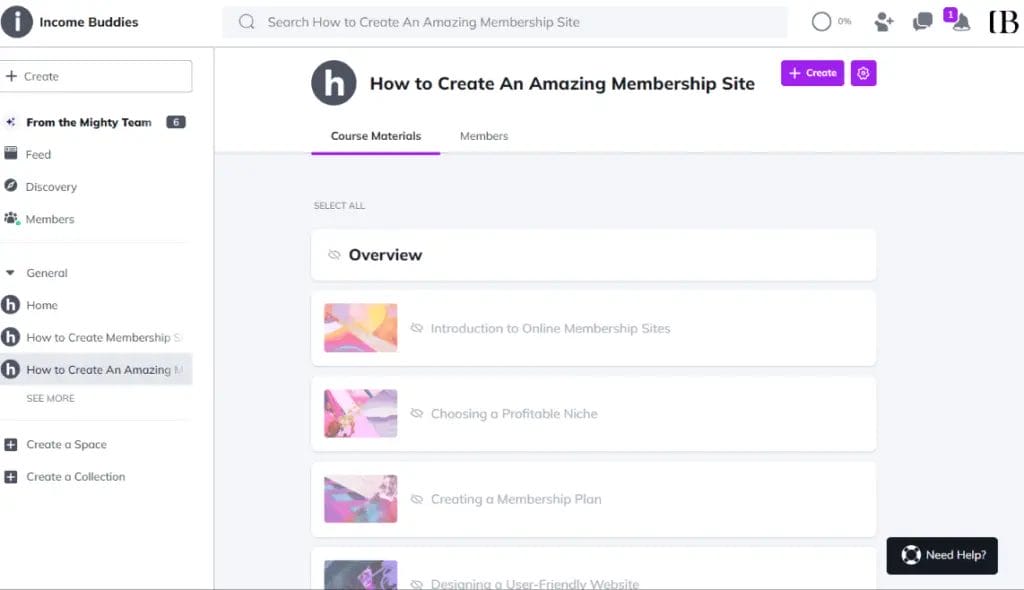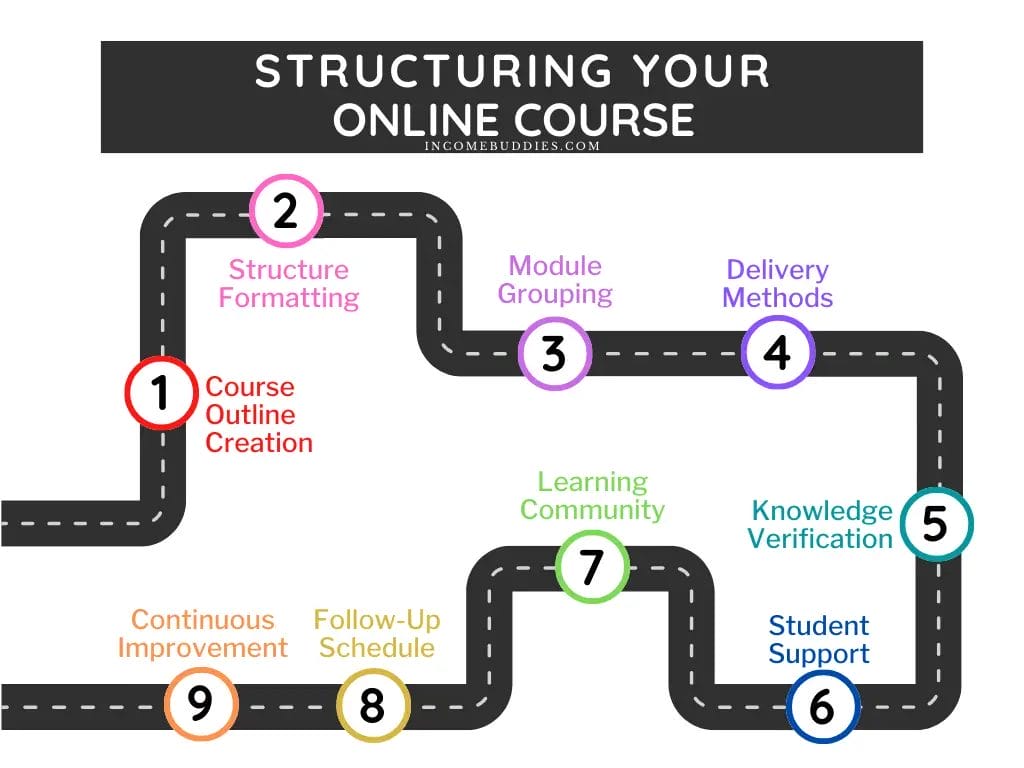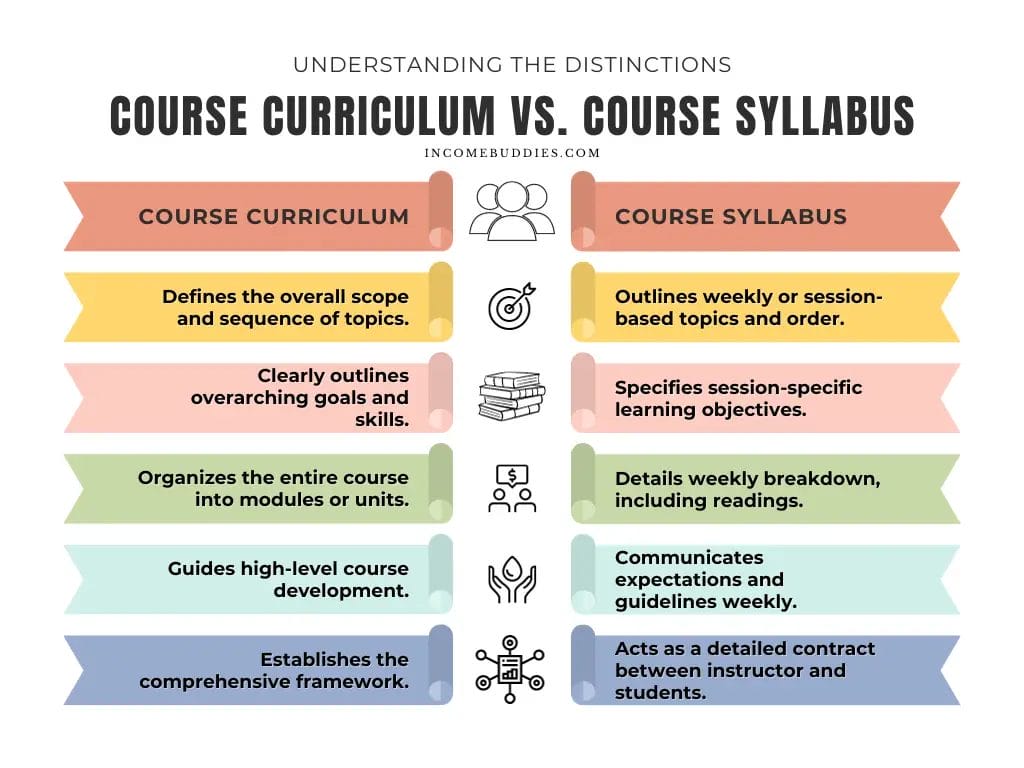How to Create an Online Course Curriculum That Sells (with Template)
Are you a course creator or edupreneur looking to learn how to create a course curriculum for your online course?
Many new course creators make the mistake of skipping this step and jump right into creating content for your online course.
Create and sell your online course is a structured process and creating a curriculum gives you a clear picture on how you should make your course.
KEY TAKEAWAYS
- For course creators, developing a curriculum is vital, serving as a structured guide for both educators and learners throughout the online learning process.
- Steps in creating a course curriculum includes; Research your audience, choose a course topic, assess market demand, define learning outcomes, develop course outline.
- Design best practices includes; using effective formatting, choose a user-friendly online platform and embracing continuous improvement.
What Is a Course Curriculum For Your Online Course?
A course curriculum serves as a roadmap, that constructs the foundation of your online course, ensuring that the knowledge imparted is organized logically for optimal understanding.
The curriculum guide your students through the learning experience from start to finish. It is a detailed plan that outlines the lessons, course content, and the objectives your course will cover.
Breaking down what outcomes students can expect upon completion.
In simple terms, your course curriculum is where you translate your expertise into digestible modules and units that facilitate learning.
How to Create an Online Course Curriculum as an Online Course Creator

Creating an online course involves careful planning and understanding of what your students need and want to learn.
Each step you take should bring them closer to mastering the subject and achieving their goals.
1. Research Your Target Audience and Understand Their Pain Point
Begin by understanding who your students are and what challenges they face.
- Who are your audience?
- What are your audience looking for?
- Why these concerns your audience?
Your course should aim to address these challenges and meet their learning needs.
2. Choose The Perfect Course Topic Idea
Your topic should not only spark interest but also offer value.
While there are 100s of course ideas you can choose from, not all topic ideas are made the same.
- Select a topic that you’re knowledgeable about.
- Pick the topic that you’re passionate to teach.
3. Determine Course Topic Market Demand
To ensure that your efforts resonate with a wider audience, gauge the market demand for your course topic.
- Determine existing market demanded
- Determine if it is something your audience wants
- Determine market potential and your competition level
Tools and surveys can help assess interest levels and the needs of potential students.
4. Create Magnetic and Compelling Course Learning Outcome
Clearly define what students will gain from your course.
Each learning outcome should be:
- Transformative: A change that empowers students with new skills or knowledge.
- Related: Something that your audience is concern and wants to know and learn.
- Personalized: The learning outcome should feel personalized to your audience, making it unique amount all related course.
5. Create Course Structure For Your Course Plan

Construct a skeleton for your course by outlining the main sections.
Organize content logically to enable students to progress through learning milestones.
6. Create Your Course Outline and Learning Models
An effective course outline is the backbone of your curriculum.
This should include modules, lessons, and the types of content you’ll provide, whether it’s video, text, or interactive media.
7. Create Course Content, Materials and Resources
High-quality content is crucial for student engagement.
Develop compelling content that educates and motivates your students, utilizing various resources to cater to different learning styles.
8. Group Lessons into Sections
Breaking down content into digestible sections helps students understand and retain information.
Each section should consist of several related lessons that build upon each other.
9. Estimate Time to Complete Each Sections
Give your students a clear expectation of the time commitment required for each section of the course.
This helps in managing their time and staying on track with their learning goals.
By breaking down the process into these targeted steps, you’ll create an online course curriculum that not only educates but also truly engages your students, guiding them to complete your course.
Course Curriculum vs. Course Syllabus: Understanding the Distinctions
Many of my readers ask “What is the difference between Course Curriculum and Course Syllabus?“
While course curriculum is often used interchangeably with course syllabus, there are some key distinction between these two.
They serve distinct purposes when creating and selling your online course.

Course Curriculum
The course curriculum is the comprehensive framework that outlines the entire educational journey. It encompasses the overall structure, content, and learning objectives of the course.
Think of it as the big picture, providing a roadmap for the entire learning experience.
Key Characteristics of a Course Curriculum:
- Scope and Sequence: Defines the scope of the course and the sequence in which topics are presented.
- Learning Objectives: Clearly outlines the goals and skills students are expected to acquire by the end of the course.
- Modules and Sessions: Organizes the course into modules, sessions, or units, detailing what each section covers.
Purpose of a Course Curriculum:
- Guides course development from a high-level perspective.
- Ensures a cohesive and structured learning experience.
- Aligns with educational goals and standards.
Syllabus
On the other hand, the syllabus zooms in on the finer details of the course. It is a more detailed document that provides specific information about individual sessions, assignments, assessments, and classroom policies.
The syllabus acts as a contract between the instructor and the students, offering a snapshot of what to expect on a week-to-week basis.
Key Characteristics of a Syllabus:
- Weekly Schedule: Outlines the topics, readings, and activities for each week or session.
- Assessment Details: Describes the types of assessments, grading criteria, and evaluation methods.
- Policies: Includes attendance policies, late submission guidelines, and other course-specific rules.
Purpose of a Syllabus:
- Communicates expectations and guidelines to students.
- Serves as a reference point for both instructors and learners throughout the course.
- Provides a detailed breakdown of the course content and assessment structure.
Bridging the Gap Between Course Curriculum and Course Syllabus
The course curriculum sets the stage for the entire learning experience, while the syllabus dives into the specifics of each session.
The curriculum is the overarching plan, and the syllabus is the detailed guide for day-to-day activities.
| Characteristic | Course Curriculum | Syllabus |
|---|---|---|
| Focus | Big picture, overall course structure. | Week-to-week details, specific sessions. |
| Objectives | Broad goals and skills for the course. | Specific objectives for each session. |
| Structure | Modules, sessions, outlines the journey. | Weekly breakdown, details on activities. |
| Purpose | Guides course development. | Communicates expectations to students. |
| Details Covered | Entire course content and objectives. | Session-specific information and policies. |
| Format | Broad, comprehensive framework. | Detailed, session-by-session breakdown. |
| Usage Timeframe | Course development stage. | Throughout the course, referenced often. |
Understanding the nuances of both documents is crucial for educators to design a well-structured course that meets educational objectives and provides a clear roadmap for students throughout their learning journey.
Online Course Curriculum Template
Building your course from scratch is never easy, however, with a template, it can helps guide you on your online course creation and complete your course easier.
Course Title: [Enter Your Course Title]
Introduction
- Welcome Message: [Briefly welcome students and set the tone for the course]
- Overview: [Provide a concise overview of the course and its goals]
Module 1: [Module Title]
Learning Objectives:
- Objective 1: [Specific goal or skill]
- Objective 2: [Another goal or skill]
Session 1: [Session Title]
- Key Takeaways: [Bullet points summarizing main points]
- Assignments/Assessments: [Any relevant tasks for participants]
Session 2: [Session Title]
- Key Takeaways: [Bullet points summarizing main points]
- Assignments/Assessments: [Any relevant tasks for participants]
Module 2: [Module Title]
[Repeat the structure for each additional module]
Resources
- Recommended Readings: [List of books, articles, or online resources]
- Supplementary Videos: [Include links to relevant videos]
- Additional Resources: [Provide any extra materials for in-depth exploration]
Assessment Methods
- Quizzes and Assignments: [Specify types and frequency]
- Interactive Activities: [Describe activities that engage learners]
- Group Projects: [Include any collaborative assignments]
Tips to Create Your Online Course Curriculum
When creating an online course curriculum, there are a few tips and best practices that you may want to adopt.
Adopt Good Formatting Practices
- Utilize Bold: Format your words to emphasize important information.
- Employ Italics: Use italics to highlight key points.
- Organize with Tables: Create tables for easy readability, it is perfect for comparison tables and statistics.
- Use Lists: Clearly present learning objectives and resources which cater to today’s audience who have lower attention span.
- Use Headlines: Create sub-headlines to help your audience when they are scanning your course, which improve readability.
Online Course Platform Selection
Choose a user-friendly platform that offers easy to use course builders, such as drag-and-drop course creators and no coding course creators.
When choosing your course platform ensure it aligns with both your needs and the audience’s for seamless course creation and delivery.
Get started with these suggestions:
- Course platform for both beginners and seasoned course creators
- Course platform with ability to create your own APP
- Course platforms that let you create your own branded certificate for your learners.
There is no one size fits all course platform, thus you should always assess your own needs and preference.
Continuous Improvement
Stay flexible and adapt based on student feedback.
Regularly update the curriculum to maintain relevance and improve the overall learning experience.
- 7 Best Teachable Alternative for Course Creators (Free and Paid)
- LearnWorlds Features: In-Depth eLearning LMS Overview
- ThinkiFic Features: Course Creator’s In-Depth Overview
- +59 Best Proven Membership Site Ideas to Get Started This Year (Read First)
- Passion.io Review 2024: Still The Best App For Coaches & Creators? (Limited Time Lifetime Deal)
Join 900+ BUDDIES who are growing their wealth with our weekly Income Newsletter
Antony C. is a dividend investor with over 15+ years of investing experience. He’s also the book author of “Start Small, Dream Big“, certified PMP® holder and founder of IncomeBuddies.com (IB). At IB, he share his personal journey and expertise on growing passive income through dividend investing and building online business. Antony has been featured in global news outlet including Yahoo Finance, Nasdaq and Non Fiction Author Association (NFAA).

